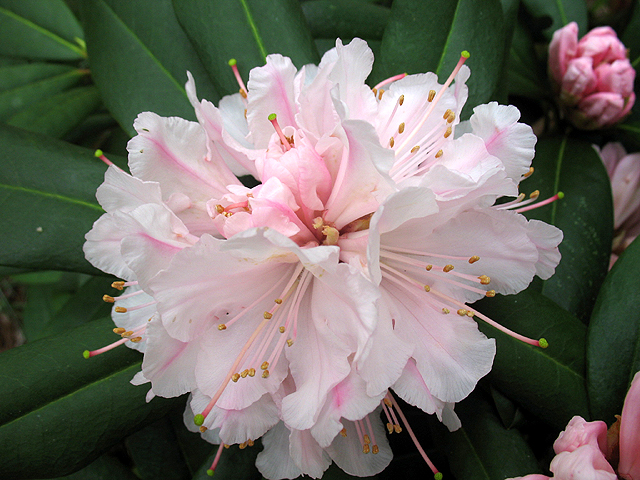PLANT STRUCTURE AND GROWTH
In order to survive, plants have evolved from single-celled, aquatic, autotrophic individuals into all sorts of species on land. Some of these land plants have enclosed seeds, called angiosperms - what we are mainly focusing on.

http://image.gardening.eu/immagini/rhododendron_jacksonii_0681.jpg
Angiosperms, such as the rhododendron above, have adapted to their non-aqueous environments in order to cope with water-loss. Now, you are wondering how? Well, I am going to tell you.
A taproot is a type of root system where one main root shoots into the soil and smaller root hairs grow from it. A fibrous root is a type of root system in which many root hairs spread out into the soil, increasing maximum surface area - this surface area helps the plant to collect more water and minerals from the soil. In the water, plants didn't have to develop root systems because they were always immersed in water, and therefore, in no need of it. The first types of land plants were mosses. These mosses didn't need the intricate root systems because they grew low to the ground and near the water. While we're on the subject, let's quickly delve into vascular tissue. The enclosed area inside the endodermis is called the stele, which represents both the xylem and the phloem. The xylem is used for water transport from the roots to leaves. The phloem is used for sucrose transport up or down the stem, from sugar source to sugar sink.
Now, let's move to the portion of the flower above ground, or the shoot system. This includes the stem, the leaves, and the flower itself. In chapter 36, the vascular tissue transport is described in depth, but quickly in lay terms, water and minerals travel upward through the roots and stems, defying gravity, in order to exit from tiny pores in the leaves, a process called transpiration. In transpiration, tiny cells in the leaves, called guard cells, serve as a sort of conductor for water release. Depending on how turgid the cell is or how full it is of solute, small pores in the guard cells, called stomata, will open up in order to release water and O2 (accumulated in photosynthesis reactions). In compromise, the air will give the leaves carbon dioxide that will help increase levels of photosynthesis and sugar production. In order to restrain too much water being lost from the plant, these leaves adapt by forming a waxy cuticle.
Near the flower, stems branch off, creating a space for axillary buds. These buds are mostly dormant, lying in the crooks of branching plants, but allow for growth when needed. Buds that are more likely to grow are called terminal buds - terminal because they grow near the end or top of the plant. Terminal buds grow more easily than axillary buds because of evolutionary adaptations - the terminal buds are more easy to access by rainwater, sunlight, and pollinating buds. A phenomenon called apical dominance describes the relationship between terminal and axillary buds. Basically, according to the principle, if anything were to happen to the terminal buds, axillary buds would then break dormancy and begin their growth.
Growth in a plant has many categories. Let's start with direction. Secondary growth describes the widening of plants in growth. This is common in woody plants, such as trees - in order to obtain the stamina to survive against animals and harsh weather conditions, a tree must toughen its bark and grow outward. Primary growth describes the up-and-down growth of a plant, such as in flowering angiosperms. Take a simple flower - in order to compete with surrounding flowers for sunlight and rainwater, the flower must grow upward to obtain air particles and downward to obtain water and mineral molecules.
Alright, now let's go way inside the plant to the molecular level - I know you're dreading this, but let's rip the BandAid - it has to be done. Let's take a look at a water-dwelling plant, such as the kelp in this kelp forest:
http://www.teara.govt.nz/files/p4595doc.jpg
As you can see, back when plants were only aqueous organisms, they didn't need support to stand upright because they were swaying around in the water. Once terrestrial, the following cells helped to keep the plant standing as well as helping with basic functions. Parenchyma cells are cells that have thin primary walls. Since they don't have much bulk to help with support, these parenchyma help with basic metabolic functions and cell storage. The next level up, or collenchyma cells, are a bit more muscular than parenchyma, having thicker primary walls. Still, they are not strong enough to support a mature plant, so mostly they support a younger plant. On top are the sclerechyma cells. These cells have thick secondary walls that allow them to support a mature plant.
Okay, now moving into the vascular tissue of the plant. Let's start with xylem cells. I think of vessel elements and tracheids sort of as water slides in the xylem. Once they have matured, their insides basically die out, but their shells remain, and these shells function as container-like structures for water transport. These elongated cells allow water to be transported into the xylem and up to the leaves.
The phloem has their help from sieve-tube elements and companion cells. Here's my analogy: There is a politician who is not too bright and therefore, must require help from his subordinates who provide him with helpful ideas while the politician increases his public relations. In this scenario, the sieve tube elements represent the politician while the companion cells represent the working people. Sieve-tubes are cells that have no helpful organelles, such as nuclei or ribosomes. The companion cells, containing both of these organelles, provides the sieve-tube elements with these assets.
Now you know the basic structure of an angiosperm. Happy studying!










